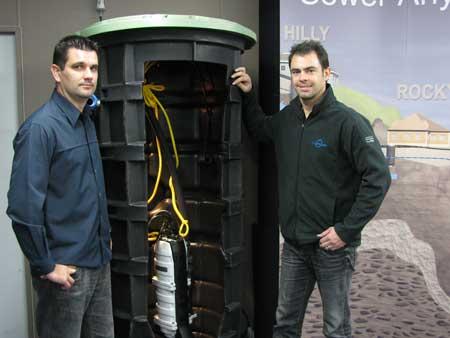| NEW Zealand’s local councils are quickly catching on to a vastly superior alternative to old traditional septic tanks and, surprisingly, it’s a concept that has been around, and internationally proven, since the 1960s. The shortcomings of septic tank systems have been well documented over the years. These somewhat primitive sewerage treatment systems are renowned for their odour problems, concrete lining degradation, leaching and overflows – which often results in pollution of the local environment and health risks. And because they are often gravity fed, septic tanks can also be expensive to install. Most local councils are cracking down on effluent quality and in many regions and towns septic tanks have now been banned. The alternative is the EOne pressurised wastewater collection (PWC) system, based on quiet, reliable grinder pumps. It’s a technology invented around 40 years ago in the US, since proven and refined, and introduced to the New Zealand market four years ago by the sole local distributor Ecoflow Ltd – based on Auckland’s North Shore. Ecoflow project managers Karl Sentch and Jon McGettigan have many years combined experience in wastewater engineering, as well as a wealth of local success stories for the EOne sewer systems. They have already installed around 4000 units throughout the country, including substantial lakeside community projects at Rotorua, and housing projects at Huapai and Kumeu, north of Auckland. So how do these PWC sewer systems work? And what are their unique benefits? Their simplicity surprises most people. Buried unobtrusively just below the ground surface in a New Zealand-made, heavy duty polyethylene chamber, the units are based around a 0.75kW GP 2000i submersible, positive displacement grinder pump, with progressing cavity to deliver an almost constant flow to the council’s central treatment plant. “Standard centrifugal type pumps wouldn’t handle the fluctuations in pressure like these pumps,” explains Karl Sentch. “These pumps simply lift out and are extremely easy to maintain.” Pressure switches in the pump head for starting and stopping the pump are similar to washing machine controls and eliminate the need for float switches which are known to fail. An integral check valve protects against system back pressure and an anti-siphon valve facilitates downhill pumping applications. The pump also features hardened stainless steel cutter bars and teeth. These create a shearing action and, coupled with the high torque pump, eliminate blockages. The EOne installation also comes complete with an IP65 weather-proof alarm panel which protects the pump from low voltage, running dry and over pressure situations. The alarms are backed up by Ecoflow’s 24-hour service line (Ecoflow’s turn-key service extends from initial design phase, through to installation, commissioning and full back-up support). Sentch and McGettigan say pressurised sewer systems are well suited to New Zealand’s terrain and they firmly believe that they will become the “new norm” in a world that is becoming increasingly conscious of the need to maintain clean environments. |
Running costs are not an issue either – the estimated annual power consumption is around $25, depending on the household’s water consumption – and there’s an estimated life expectancy on the pump’s wearing parts of around ten years. The EOne system comes with a standard two-year warranty, but extended warranties and different levels of service contract are available. |






